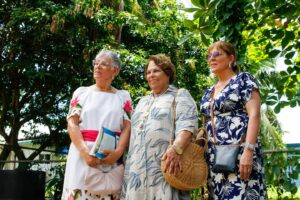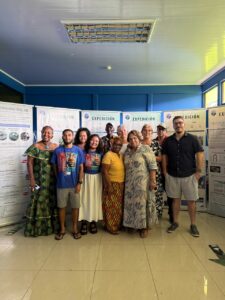María Suárez Toro, CCBEM
April 27, 2025
Today when Cahuita, its National Park, Ambassadors of the Sea and collaborators announced the scientific results of the identity of the wrecks in Cahuita, five ascendants (relatives) of one of the African men, women, and children who disembarked from the two Danish slave ships on March 4, 1710 came to the activity in La Casa de Cultura del Calypso.

As if bearing witness, not only about the factual information regarding the whereabouts of Fredericus IV and the Christianus V Danish slave ships that arrived in Cahuita in Costa Rica, but also about the fact that the 650 Africans who disembarked on the shore. Three relatives of Miguel Maroto, who were there that day, are among us. (photo by Voces del Caribe, 2025).
They came to bear witness. Miguel Maroto lives among them, even though they just found out about their African ancestry. They are three sisters, Celia Quesada Navarro, Ana Teresita Quesada Navarro, and Rita Isabel Quesada Navarro, daughters of 103-year-old Celia Navarro Luna, eight-generation ascendant of Miguel Maroto, who sent a video. Also, with the daughters in Cahuita came Alvaro Rojas Carballo and Alvaro Esteban Rojas Quesada as part of the delegation.

The family constituted the human present day “anchor “of a 315 year old arrival of enslaved Africanas in Costa Rica that can be traced to the present day. The family constituted the human present-day “anchor “of a 315-year-old arrival of enslaved Africans in Costa Rica that can be traced to the present day. Matoro’s lineage has been identified because there’s sufficient archival information to follow the story’s trail, and it is scientifically known today, due to the tenacious ethnographic work of the university professor and researcher Mauricio Meléndez.
Maroto’s relatives with Embajadores
and community leaders. (photo by Voces del Caribe, 2025).
Furthermore, the interest in the ethnographic research wouldn’t have received such attention had it not been for the fact that Centro Comunitario de Buceo’s nine-year-old work came to fruition by setting the scientific record straight about the arrival of the ships. Everything is so connected!
It was in the 2016 Seminar by Fundación Arte y Cultura para el Desarrollo (FUACDES), Centro Comunitario de Buceo (CCBEM), UNESCO, and others, that attention to Miguel Maroto’s story emerged for the first time, associated with the CCBEM project to search for the identity of the ships.
“Miguel never imagined when he disembarked after the forced journey in 1710 that he would find a new lineage in Costa Rica, so far from his place of origin in West Africa and establish new relationships in a new world,” concluded Mauricio Meléndez at the time in 2016 and who in 2024 ended his ethnographic study with the support of the Danish National TV who met with the present day relatives of Miguel Maroto.
Today, Miguel Maroto’s family – eight generations down – joined Ambassadors of the Sea in its announcement of the scientific evidence of the identity of the ship where their relative came 315 years ago.
Celia Quesada Navarro, presently living in Cartago, very close to where Miguel was bought and sold as an enslaved person 315 years ago, told Ambassadors of the Sea that her 103-year-old descendant of Miguel Maroto is very happy to have found her ancestry, even so late in life. “We came to commemorate with you, because this has brought new light to our lives – said Celia, who had no clue about their African legacy until now.
(Video:
The Story
In 2016,* Meléndez recounted that “the ascendants of the ships must live among us to this day, and we might know because when 105 were recaptured in Matina north of Cahuita, they were sold, bought and re enslaved, so their traces are in documents of the epoch in archives.”
So, Meléndez set out to contribute to finding them, as is his passion and profession. According to Meléndez, since his presentation at the Seminar, one of them who appears in the National Archives in Costa Rica was Miguel Maroto.
He arrived either on the Christianus V or Fredericus IV Danish slave ships along with 650 other people who disembarked free, despite having been brought to be enslaved in the Americas.
Along with 105 other enslaved men and women, he was captured four months after his arrival. Documentation indicates that it was initially from Benin or Togo in West Africa, formerly known as Dahomey. His original African language may have been Fon or Yoruba, if he came from Benin, and Ewe or Kabiyé, if he came from Togo. We know this because he has been identified as part of the Mina caste in Africa.
His name was undoubtedly African upon arrival, but as he was recaptured and re-enslaved, he was given a Spanish name and later the surname of one of his masters, who bought him.
Who he was
Miguel Maroto, born in 1694, was a teenager when he landed on the coast of Costa Rica’s southern Caribbean in 1710. He was sixteen years old upon arrival, the same age as the youth Ambassadors of the Sea doing the research today about the slave ships that brought him to Costa Rica.
Miguel testified 10 years later, after his arrival and recapture in 1710, in a trial by the Spanish Monarchy against the enslavers who bought him in Cartago because they did not pay taxes for him!
He stated in his testimony that he entered through Matina from a beach when the ship had run aground. According to other documents, the ship that ran aground was the Christianus V.
They had arrived on March 2, and he was captured with four others four months later in June. He was careered alongside others, such as “María Capitana”, a black woman of the Mina caste born around 1689, who was 20 years old, and “Francisco Maroto”, an Aná caste member born around the same time. Another black man, “Miguel,” was illegally acquired by doña Luisa Calvo de Maroto, an enslaver from Cartago, alongside 60 others.
Calvo was subjected to an investigation commissioned in 1719 against her and also against almost all the slave-owning families in the area of Cartago (the then capital of the Spanish Province of Costa Rica), who took Africans who also arrived in the ships. Governor Diego de la Haya Fernández investigated orders from the Spanish Crown.
The reason was that there had been such a large illegal slave trade at the time that the Crown decided it should be investigated so that the guilty parties would pay the corresponding taxes for the “merchandise” they stole.
The investigation, which culminated in 1722, resulted in almost all the guilty parties paying the taxes to keep the enslaved they had illegally acquired.
Doña Luisa ended up having to pay 200 pesos worth of cocoa for Miguel Maroto because, although she presented a Deed of Purchase for him in 1681, it was not accepted, so she had to pay. Luisa Calvo de Maroto is well known in the history of the time for her participation in the illegal trade, according to Tatiana Lobo’s book, together with Meléndez, “Negros y Blancos Todo Mezclado.”**
Mrs. Calvo de Maroto was also investigated for her other enslaved, but they were declared “in good standing” because they had been legally acquired.
On August 19, 1727, Calvo donated her enslaved Miguel Maroto to her grandson, the priest José Díaz de Herrera. He almost immediately sold him for 400 pesos worth of cocoa to Ensign Francisco Gutiérrez, a local cocoa farmer. In 1730, Gutiérrez sold Miguel to Berdanrdo García de Miranda for the same amount.
In 1716, Miguel Maroto married Petronila Calvo, a free mulatto woman, perhaps descended from the Calvo family and possibly of mixed Spanish and African heritage, and therefore a free mulatto woman.
It should be remembered that Luisa, whose surname was Calvo, was married to José Maroto. When Miguel and Petronila’s children appear in records, he is identified as a free mulatto like her, although his manumission document is unknown. He was cited as something between “bozal” (the word for a recent arrival who didn’t know Spanish) and “ladino” (the word for a person who had adapted).
They had six children: José Ermeregildo, born in 1716; Andrés in 1719; María Gertrudis in 1724; María Candelaria in 1727; Manuela Antonia in 1736; and María Narcisa, born in 1739.
They worked in the cacao industry in Matina, first as enslaved (although it should be remembered that the children of a free woman were born free) and then as children, considering that the mother inherited slavery, and Petronila was a free mulatto.
All of them had children to this day, except one. It is unknown when Miguel died, but his widow, Petronila, lived until January 16, 1765, and was buried in the Church of Los Ángeles in Cartago.
Although relatives do not bear the last names Maroto or Calvo today, the Maroto name prevailed. In the 19th century, they used the Maroto name, but they are also Carvajal, Brenes, Barrios, Rivera, and Salazar, among others.
End
*Seminario “Verdades Ocultas en el Mar” en la Escuela Excelencia Cahuita, organizado por FUACDES, CCBEM y otros.
**”Negros y blancos: todo mezclado”. Tatiana Lobo, Mauricio Meléndez Obando. Editorial de la Universidad de Costa Rica, 1997.

